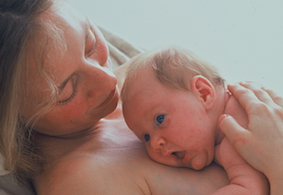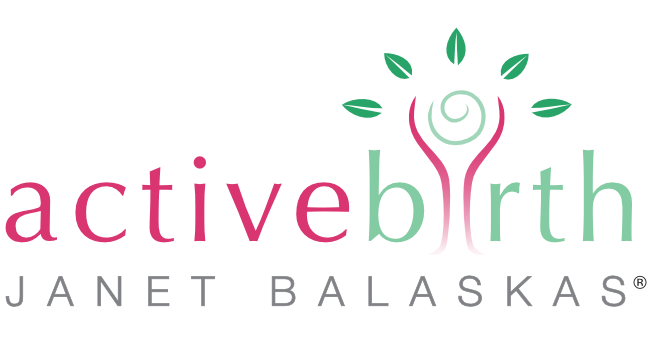
I have always marvelled at the way nature has provided the newborn baby with a double lifeline in the critical period immediately after birth. Moments after birth, the baby takes its first independent breath. It takes a few minutes for changes to occur in the chambers of the baby’s heart so that is begins to pump blood through the its own lungs, instead of through the cord to the placenta and back. While independent lung breathing is beginning, the placental circulation continues, providing the baby with oxygenated blood until lung breathing is fully established. This is a gradual ending to the placental circulation until blood is no longer flowing through the umbilical cord and it appears flaccid and white. Provided no drugs have been administered, there is no reason to hurry to cut the cord. In fact in a truly physiological birth the cord need not be cut until after the placenta has been born and this practise is becoming more common – even after a caesarean section.
 The Royal College of Obstetricians and Gynaecologists has published new clinical guidance on the timing of cord clamping and the placental transfusion that makes for interesting reading.
The Royal College of Obstetricians and Gynaecologists has published new clinical guidance on the timing of cord clamping and the placental transfusion that makes for interesting reading.
Clamping of the Umbilical Cord and Placental Transfusion
My long term colleague in the foundation of the Active Birth Movement, the obstetrician Yehudi Gordon, drew my attention yesterday to the news with this comment:
‘After 34 years the RCOG has recognised that the physiology of the umbilical cord is well organised and nature does not need help from adults who have no idea of how the mechanism works.’
In the early 1980’s Yehudi and I began to advocate a delay in clamping or cutting the cord when there is no indication to do so, until the pulsation had ceased naturally.
 Over the decades science and research have gradually been providing the evidence that this is indeed important for a variety of reasons including the important comparative increase in the baby’s iron stores established by the Swedish study published in the BMJ that stimulated the new guidelines. The ‘placental transfusion’ is a term we welcome being used by the RCOG. I describe it to parents as ‘mother nature’s packed lunch’ – full of health giving nutrients to sustain the baby through the transition from the womb into life outside the womb. For more on this read my blog post Precious Placenta.
Over the decades science and research have gradually been providing the evidence that this is indeed important for a variety of reasons including the important comparative increase in the baby’s iron stores established by the Swedish study published in the BMJ that stimulated the new guidelines. The ‘placental transfusion’ is a term we welcome being used by the RCOG. I describe it to parents as ‘mother nature’s packed lunch’ – full of health giving nutrients to sustain the baby through the transition from the womb into life outside the womb. For more on this read my blog post Precious Placenta.
This is a time when many of the baby’s independent organic functions such as breathing, digestion and excretion are starting for the first time. The brain, kidneys, liver and other organs are going to require very good oxygenation. So nature provides a super rich blood supply, full of iron rich haemoglobin – the oxygen carrying red blood cells in the last blood, coming from the placenta.
These new guidelines are music to the ears of people like us, who can now pass on the information of the RCOG guidance to parents. This will support and back up their request that, if there is no complication, the cord remain intact at least in the few minutes after birth, or until it has stopped pulsating.
However, while this is a welcome step, there is further to go in the awareness of the physiology of this stage of the birth. The placental transfusion also contains important immune factors and Vitamin K for example, which the baby cannot yet make for itself and not least a store of stem cells. The harvesting of stem cells for storage in a blood bank for use in later life is a practice that robs the baby of the placental transfusion. Sadly parents are sometimes asked to donate or privately bank these stem cells – all of which reflects the ignorance of the physiology of this vital stage of the birth process.
I would like to comment further on this passage cited in the RCOG Scientific Impact Paper:
Clamping of the Umbilical Cord and Placental Transfusion (Scientific Impact Paper No. 14)
 In this passage the paper says: “After birth, blood flow in the umbilical arteries and veins usually continues for a few minutes. The additional blood volume transferred to the baby during this time is known as placental transfusion. Immediate clamping of the umbilical cord has traditionally been recommended as part of active management of the third stage of labour, together with a prophylactic uterotonic drug and controlled cord traction, to reduce postpartum haemorrhage. Use of a prophylactic uterotonic drug clearly does reduce the risk of major haemorrhage. The timing of cord clamping does not appear to have a major impact on blood loss at the time of birth.”
In this passage the paper says: “After birth, blood flow in the umbilical arteries and veins usually continues for a few minutes. The additional blood volume transferred to the baby during this time is known as placental transfusion. Immediate clamping of the umbilical cord has traditionally been recommended as part of active management of the third stage of labour, together with a prophylactic uterotonic drug and controlled cord traction, to reduce postpartum haemorrhage. Use of a prophylactic uterotonic drug clearly does reduce the risk of major haemorrhage. The timing of cord clamping does not appear to have a major impact on blood loss at the time of birth.”
Nature also has its own physiological mechanisms to prevent postpartum haemorrhage. When birth is truly undisturbed and this is followed by undisturbed skin-to-skin contact between mother and baby, the extraordinarily high levels of the hormone oxytocin will contract the uterus powerfully after birth, expel the placenta and seal the placental site effectively without the routine use of prophylactic uterotonic drugs.
An interesting person to follow regarding birth physiology wisdom and the research evidence is Dr Sarah Buckley.
She famously says about the first hour or so after birth:
“Don’t clamp the cord and don’t take the baby.”
So the new guidelines are good news but there is more to understand before it is widely accepted by more obstetricians that when it comes to the whole birth process, when there are no complications, nature knows best.
Janet Balaskas

